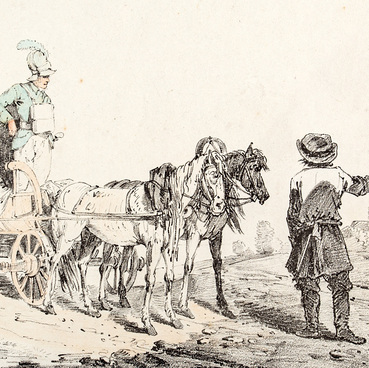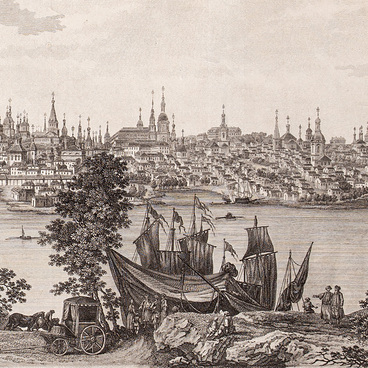The watercolor by Lev Kryukov presents a view of the estate “Three Lakes” (Rozhdestvenskoye), located in the Spassky Uyezd of the Kazan Governorate.
In 1823, the estate belonged to the Molostvov brothers — Colonel Orest Porfiryevich (1801–1870), Major General Vladimir Porfiryevich (1794–1863) and Guard Lieutenant Modest Porfiryevich (1799–1845), who inherited it from their father, a public figure and Marshal of Nobility Porfiry Lvovich Molostvov (1760–1808).
On the far shore of Lake Atman, one can see the manor house and the Church of the Nativity of Christ, erected in 1775 on the site of a wooden church built in 1716 at the expense of the landowner Lev Ivanovich Molostvov, who owned the village of Three Lakes at that time. In 1777, side chapels were added to the church and consecrated in the name of the holy martyrs, the blessed Princes Boris and Gleb and in honor of the Nativity of the Virgin. The first service in the church was held in 1778. The free-standing bell tower was erected in the first half of the 18th century.
In 1833, Alexander Pushkin passed through the Spassky Uyezd on his way from Kazan to Simbirsk. According to the poet and local historian Nikolay Maryanin, Pushkin could have stopped by at the invitation of the Molostvov brothers and visited their estate “Three Lakes”. In any case, the silhouette of a man in a top hat and with a cane, depicted in the foreground on the right side of the composition, bears a strong resemblance to the image of the great poet.
The view of the estate “Three Lakes” was made by
the artist Lev Kryukov (1783–1843). He came from the serfs of the Simbirsk
landowner Agrafena Alexandrovna Sekiotova. He studied at the Moscow studio of
the Italian artist Claude and was mentored by the professor of the Academy of
Arts Dmitry Levitsky. In 1806, he became a freedman and settled in Kazan. He
taught drawing and composition at Kazan University (1807–1841). In 1813, as a
draftsman, he accompanied a scientific expedition to Bolgar, making sketches
and layout drawings of ancient ruins. In 1814, he participated in the
organization of celebrations for the tenth anniversary of the university as an
“illuminator”. In 1830, he made a project of the monument to the poet Gavriil
Romanovich Derzhavin; his project at the Academy of Arts was considered
“unsatisfactory”. The artist received commissions from private individuals to
create miniature and “life-size” portraits, taught painting as a tutor and
painted icons.


